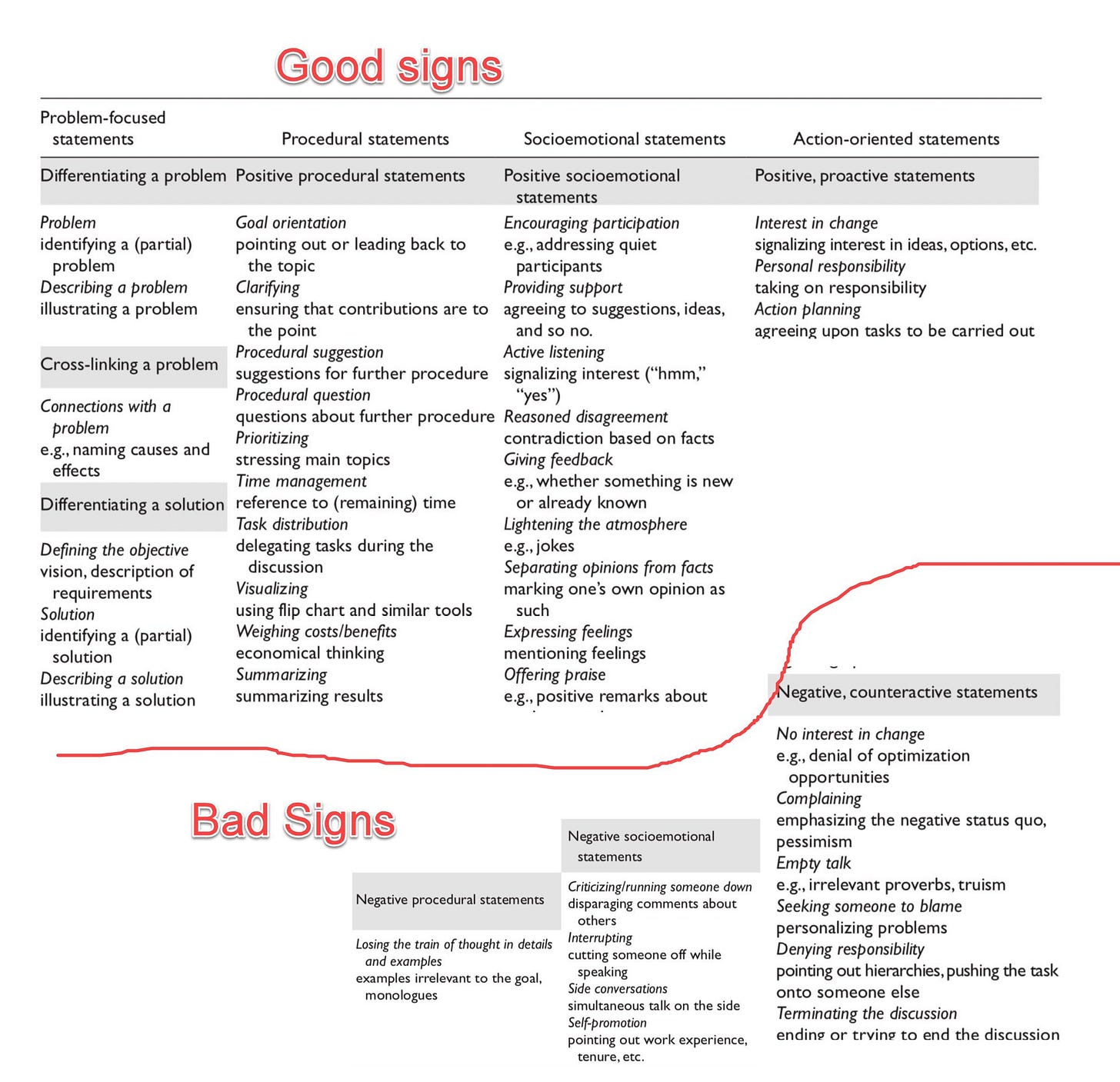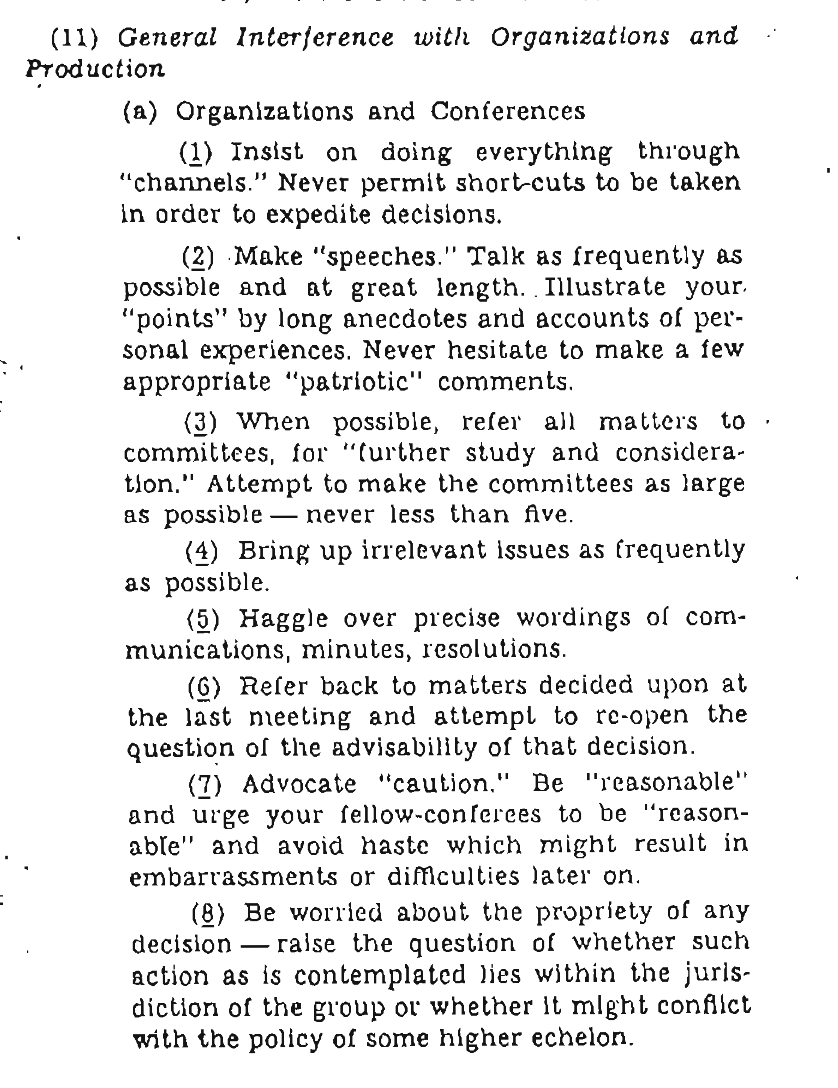Meetings should be a fascinating topic.
They define our work (we spend 15% of work in meetings, and managers spend 50%!), and they account for an astonishingly large amount of corporate cost (there are 55 million meetings a day!) Yet we mostly hate them and we do surprisingly little to make them better.
Since meetings are so common and so important, they should actually be the focus of experimentation for managers and companies. Trying something new in how you run a meeting is remarkably easy, and, if it doesn’t work, the downside risk is reasonably small. In fact, the number one piece of advice in this excellent list of meeting tips is to experiment! But where should you start your experiments?
In this post, I hope to give some hints based on the science of meetings. For such a ubiquitous topic, it is not as well-studied as you might expect, but there is enough reseach to provide some suggestions about what makes meetings good, or bad.
First, let’s establish that meetings matter. This paper found good meetings were not only linked to happier teams, but were also associated with organization success 2.5 years later. Good meetings focused on planning & problem-solving; bad ones had more complaining. Here's a list of the signs of a good or bad meeting that should seem pretty familiar…
So how do you make a meeting better? This review article has some useful tips. Lets dive in to the findings:
Before the Meeting
👥Develop a language and culture for meetings. Meetings are as important to your team and organizations success as anything else you do. Be deliberate in setting up your meeting culture, and, as a leader, model it for everyone else. You can use specialized vocabulary (a “stand up” might serve a different purpose than a “status report”) but, please, make meetings something you think about.
✅Only meet if needed. Ask yourself if a meeting is the optimal solution. Then make sure to only invite people who need to be there. Make sure it is short and relevent.
🎯Plan your meetings. Be deliberate about thinking about the structure - you are about to take people’s valuable time. How will you use it? Set clear goals and outcomes for the meeting in advance. Define the purpose and the stakes for everyone involved. Consider having an agenda for everyone to review in advance.
During the Meeting
⏱Arrive on time. SERIOUSLY, ARRIVE ON TIME. This paper finds that meetings which start late don't just annoy participants, they are also much less productive and creative. And making a habit of lateness hurts. Just the anticipation of a late meeting has similar effects.
🥇Have a leader. This doesn’t need to be the leader of your team, or the most senior person in the room, but meetings work best with a single clear leader. This person can intervene if the topic drifts, make sure everyone participates (see below), and keep everyone focused on tasks. The leader can also summarize points made and push for a conclusion. Research is pretty clear on this point - have a meeting leader!
🙋♀️🙋♂️Everyone participates. Why invite people who don’t add to the meeting? And general particpation is important for buy-in and to make sure that you get the benefits of all the minds in the room. As a leader, you can encourage this process by calling on people, speaking to them in advance to encourage them to talk, or increasing psychological safety. You can even use your eyes. When leaders gaze positively at group members who might otherwise be left out (like lower-status members), other people in the group listen to that person more & group performance increases. Eye gaze also increases people's willingness to contribute to group discussions.
💻📱Never multitask. We aren’t good at multitasking, and it will destroy the value of the meeting as people stop paying attention to what is being said and do other things. As a leader, model this behavior.
🗲Experiment with technologies, tools, and approaches. What if you took a meeting that was in person, and made it virtual? What tools or software platforms might make your meetings better? Trying new things makes meetings more interesting, and makes it more likely you will find a new key to success. You may even want to try standing at your meetings. A study 20 years ago studied teams where some meetings were traditional sitting meetings & some standing. Sitting meetings were 34% longer than standing ones & produced no better results!
😄 Care about mood and language. Intervene if mood turns negative, as negative moods quickly spread. As the review article says: “when one person starts to complain in a meeting by expressing so-called “killer phrases” that reflect futility or an unchangeable state (e.g., “nothing can be done about that issue” or “nothing works”), other meeting attendees begin to complain, which starts a complain ing cycle that can reduce group outcomes.” Humor can help in this case.
🙅♀️Leave time for objections. Consider even asking people to come up with something that can go wrong with the decisions you are making at the end of the meeting. This allows people to safely discuss what might be wrong with a decision, and gives you a way of avoiding groupthink.
🗳Let everyone help decision-making. If a decision is made, tell everyone what the decision was.
After the meeting
📍Send action items & notes immediately. Otherwise, this material gets lost, and the meeting will be futile.
🤷🏼♀️Right after the meeting have brief after action discussion about process. If you are trying to improve how you meet, the best time to figure that out is by disecting the meeting right after you completed it. Focus on the overall meeting approach, not the details about what you discussed. Are there things you should do differently next time? How did the experiments that you tried work? Incorporate getting better at meetings into your organizational goals.
Alternately, use meetings to destroy your enemies…
One of the most revelatory management texts is actually this WWII guide to sabotage for civilians from the CIA's precursor. Look at the ideas for sabotaging office tasks to cause demoralization & delay and consider how many of them are normal parts of your meetings. Maybe avoid those next time you have a meeting?






“Good meetings focused on planning & problem-solving.”
Agreed. In my experience, pro forma (standing meetings for events like planning) go well when there is a rhythmic structure in place, a cadence, i.e., a predictable schedule and pace of events are agreed upon, e.g., we do feature strategy every 6 weeks where we decide on what projects to do next. That is, a meeting is used at a point in time for feature prioritization (we know we are deciding on what to do given everyone has asynchronously pre-read well-shaped ideas). Most meetings are bursty (quick ad hoc syncs between a given small team to clear complex questions). But, most internal communication is best when things are written down and solidified and not dissolved via synchronous chats. This is especially important in remote organizations.
All that said, the best experiments in meeting design I’ve had is when we deeply understand the underlying structure of when meetings should exist. Non-interpersonal pro forma chats are rarely spun up. SME office hours and the cadenced strategy/prioritization/decision-making meetings are really the only two useful ones I’ve experienced at product-led companies. Getting asynchronous right is hard, but pays off big time when that muscle is built up.
Nice post Ethan, Whilst reading I thought about another post of yours about creativity as well as your more recent writings about AI.
I think it would be interesting to explore how AI can assist in meeting productivity and creativity through structure and automation. For example, if AI can transcribe meetings and free up participants from taking notes, could it enable more wandering minds and spark creativity? Additionally, how could a leader benefit from AI-generated agendas that could help them choose the most productive meeting structure from a range of options? I'd love to hear your thoughts on this topic.
https://www.oneusefulthing.org/p/how-to-be-more-creative?lli=1